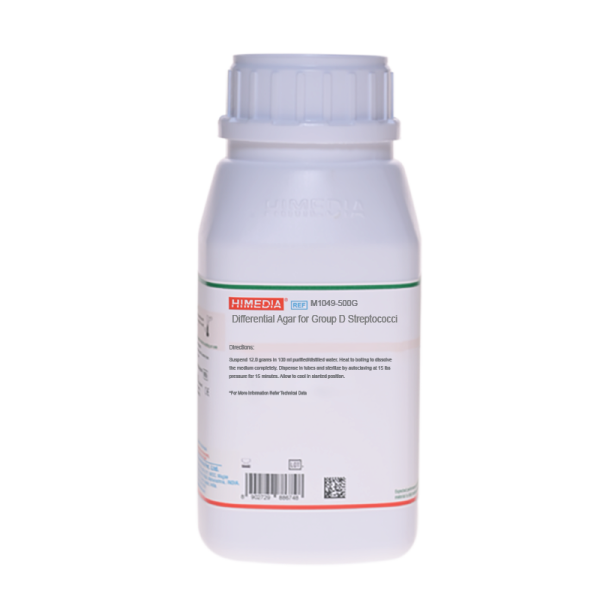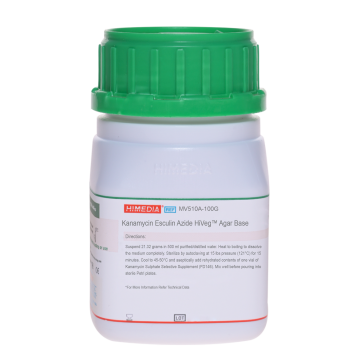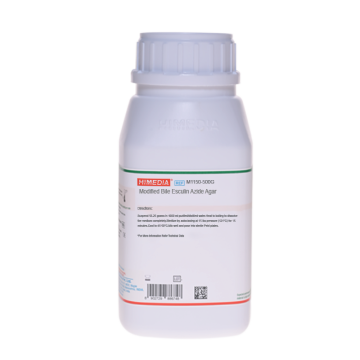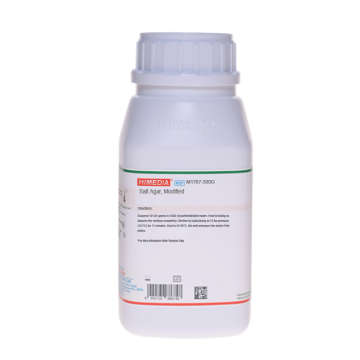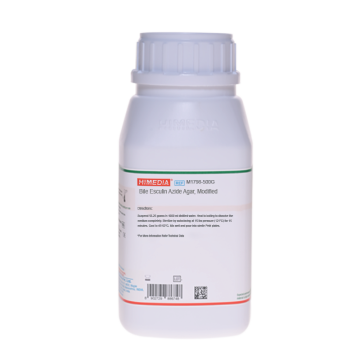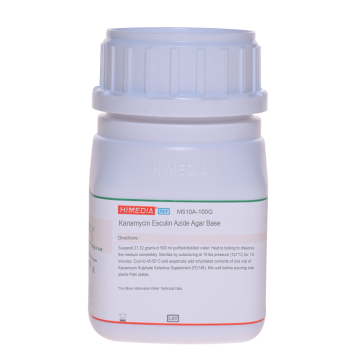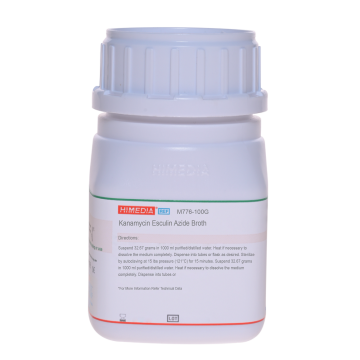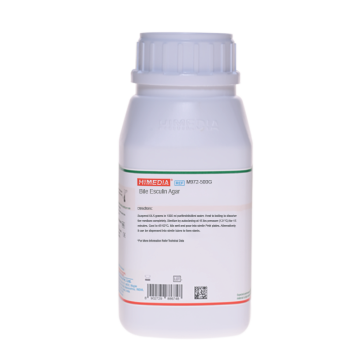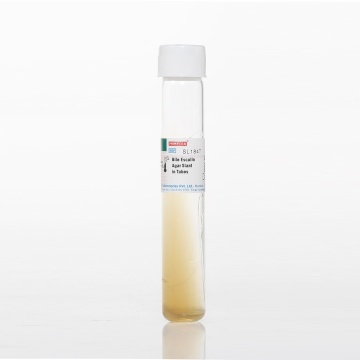 Your enquiry has been submitted
Your enquiry has been submitted
Differential Agar for Group D Streptococci
Intended Use:
Used for differentiation and identification of Group D Streptococci.
Composition**
Ingredients
| Ingredients | g/L |
|---|---|
| BHI Powder | 8.000 |
| Peptone | 5.000 |
| Tryptone | 16.000 |
| Dextrose (Glucose) | 10.000 |
| Sodium chloride | 65.000 |
| Disodium hydrogen phosphate | 2.500 |
| Bromocresol purple | 0.020 |
| Agar | 13.500 |
Final pH (at 25°C): 7.4±0.2
**Formula adjusted, standardized to suit performance parameters
Directions
Suspend 12.0 grams in 100 ml purified/distilled water. Heat to boiling to dissolve the medium completely. Dispense in tubes and sterilize by autoclaving at 15 lbs pressure for 15 minutes. Allow to cool in slanted position.
Principle And Interpretation
Most strains of Group D Streptococci are now classified in the genus Enterococcus (1). These organisms are found as normal flora in the gastrointestinal tracts of humans and animals. They are becoming increasingly important agents of human disease, largely because of their resistance to antimicrobial agents to which other Streptococci are generally susceptible (2). The most common species are Enterococcus faecalis and Enterococcus faecium. These organisms grow on media with high salt content and are usually non-haemolytic, but sometimes show alpha or beta-haemolysis. It can withstand heat at 60°C for 30 minutes, a distinguishing feature from other streptococci, and also grow within a wider temperature range (10-45°C). They ferment sugars with acid production. Differential Agar for Group D Streptococci is a modification of SF Broth (Streptococcus faecalis Broth) (3).
BHI Powder, Peptone and Tryptone in the medium provide necessary nitrogenous compounds and other essential nutrients for growth. Dextrose is the energy source. Sodium chloride at 6.5% concentration makes the medium differential for Enterococcus and Streptococcus. Growth on this medium turns yellow due to acid production. A negative reaction is indicated by no change in the purple colour of the medium.
Type of specimen
Clinical samples- faeces, rectal swabs, etc.; Water samples
Specimen Collection and Handling:
For clinical samples follow appropriate techniques for handling specimens as per established guidelines (4,5).
For water samples, follow appropriate techniques for sample collection, processing as per guidelines and local standards(6).
After use, contaminated materials must be sterilized by autoclaving before discarding.
Warning and Precautions :
In Vitro diagnostic Use. For professional use only. Read the label before opening the container. Wear protective gloves/protective clothing/eye protection/ face protection. Follow good microbiological lab practices while handling specimens and culture. Standard precautions as per established guidelines should be followed while handling clinical specimens. Safety guidelines may be referred in individual safety data sheets.
Limitations :
- Individual organisms differ in their growth requirement and may show variable growth patterns on the medium.
- Each lot of the medium has been tested for the organisms specified on the COA. It is recommended to users to validate the medium for any specific microorganism other than mentioned in the COA based on the user's unique requirement.
Performance and Evaluation
Performance of the medium is expected when used as per the direction on the label within the expiry period when stored at recommended temperature.
Quality Control
Appearance
Cream to yellow homogeneous free flowing powder
Gelling
Firm, comparable with 1.35% Agar gel.
Colour and Clarity of prepared medium
Purple coloured, clear to slightly opalescent gel forms in tubes as slants
Reaction
Reaction of 12% w/v aqueous solution at 25°C. pH: 7.4±0.2
pH
7.20-7.60
Cultural Response
Cultural characteristics observed after an incubation at 35-37°C for 24-48 hours.
| Organism | Inoculum (CFU) | Growth | Acid production |
|---|---|---|---|
| Enterococcus faecalis ATCC 29212 (00087*) | 50-100 | luxuriant | positive reaction, yellow colour |
| Enterococcus faecium ATCC 27273 | 50-100 | luxuriant | positive reaction, yellow colour |
Key: (*) Corresponding WDCM numbers.
Storage and Shelf Life
Store between 10-30°C in a tightly closed container and the prepared medium at 20-30°C. Use before expiry date on the label. On opening, product should be properly stored dry, after tightly capping the bottle in order to prevent lump formation due to the hygroscopic nature of the product. Improper storage of the product may lead to lump formation. Store in dry ventilated area protected from extremes of temperature and sources of ignition. Seal the container tightly after use. Product performance is best if used within stated expiry period.
Disposal
User must ensure safe disposal by autoclaving and/or incineration of used or unusable preparations of this product. Follow established laboratory procedures in disposing of infectious materials and material that comes into contact with clinical sample must be decontaminated and disposed of in accordance with current laboratory techniques (4,5).
Reference
- Collee J. G., Fraser A. G., Marmion B. P., Simmons A., (Eds.), Mackie and McCartney, Practical Medical Microbiology, 1996, 14th Edition, Churchill Livingstone
- Koneman E. W., Allen S. D., Janda W. M., Schreckenberger P. C., Winn W. C. Jr., 1992, Colour Atlas and Textbook of Diagnostic Microbiology, 4th Ed., J. B. Lippinccott Company Philadelphia, Pg. 440.
- Atlas R. M., 1997, Handbook of Microbiological Media, 2nd Ed., Parks L.C., (Ed.), CRC Press, New York.
- Isenberg, H.D. Clinical Microbiology Procedures Handbook 2nd Edition.
- Jorgensen, J.H., Pfaller, M.A., Carroll, K.C., Funke, G., Landry, M.L., Richter, S.S and Warnock., D.W. (2015) Manual of Clinical Microbiology, 11th Edition. Vol. 1.
- Baird R.B., Eaton A.D., and Rice E.W., (Eds.), 2015, Standard Methods for the Examination of Water and Wastewater, 23rd ed., APHA, Washington, D.C.
| Product Name | Differential Agar for Group D Streptococci |
|---|---|
| SKU | M1049 |
| Product Type | Regular |
| Physical Form | Powder |
| Origin | Animal |
| Packaging type | HDPE |
| References | 1. Collee J. G., Fraser A. G., Marmion B. P., Simmons A., (Eds.), Mackie and McCartney, Practical Medical Microbiology,1996, 14th Edition, Churchill Livingstone |
| Customized Product Available | No |



